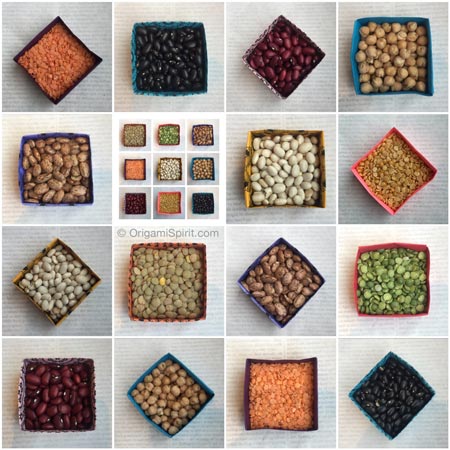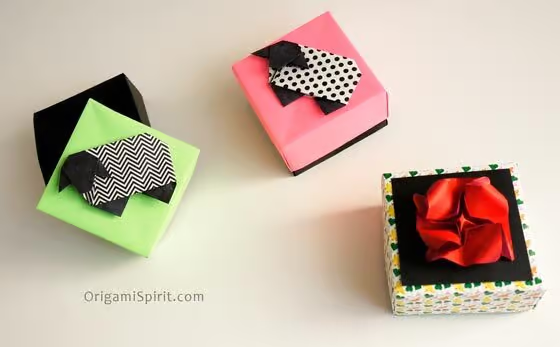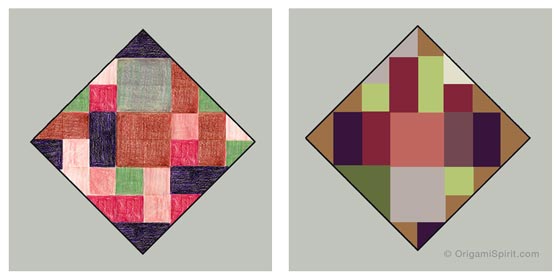Using Origami to Teach About Pulses (Grain Legumes)
© Leyla Torres*
Subjects
- Art and art history
- Science
- Language Arts
- Math
- Social Studies
Skills
- Following Directions
- Team Work
- Researching
Grades
The activities in this lesson can be adapted to children in grades 4-12
Description
Students complete hands-on and research activities to learn how to make an origami box and use it in different activities related to pulses.
Objectives
Students will:
- follow directions in completing an origami model
- identify different classes of legumes called pulses (grain legumes)
- create art pieces based on color and shape experienced as they handle and study pulses
- use the origami boxes in several cross-curricular activities
Materials
- A few 6 x 6 inch square pieces of paper per child (give them room to make mistakes when folding)
- Small amounts of dried pulses such as kidney beans, chilli beans, canellini beans, navy beans, pinto beans, adzuki beans, black-eye peas, mung beans, pigeon peas, lentils (of different colors), chickpeas (garbanzos), split peas (yellow and/or green)
- Color pencils
- Computer and Internet access for research
Vocabulary
Review with students the meaning of words such as: agriculture, grain, garbanzos, chickpeas, lentils, beans, pulses.
Building Background
Invite students to talk about what different foods they eat at home and encourage them to mention the ingredients.
- What do you like to eat for lunch or for dinner?
- What ingredients are needed to prepare it?
- How is lunch or dinner prepared?
- Have you eaten lentils, beans or chickpeas?
- How are these pulses prepared?
Integrated Curriculum activities
SCIENCE
- Invite students to read about pulses* and their importance in the human diet. (*See resources below)
- Discuss with the students the information they gather about pulses.
ART
- Invite each child to make a couple of boxes following this video for a traditional origami box. https://youtu.be/vZSiijO0TEk
- Have groups of students fill each box with a different pulse.
- Ask them to display their boxes in order from larger to smaller content size.
- Have them display all the boxes in order from the lighter to the darker color of their contents.
- Invite students to make a photographic geometric collage of boxes filled with pulses as the one shown in the photo at the top.
- Have students fold and unfold a box, then hand color each area of the unfolded paper with the color of different pulses.
- As an alternative, they can scan the folded paper and use it as template to color the sections digitally.(see examples in the photo below)
- Have students label the different colored areas with the name of the corresponding pulse.
ART HISTORY
- Study artists and cultures whose work represent geometric abstraction, such as Kasimir Malevich, Piet Mondrian and Islamic Art.
- Challenge older students to learn how to fold the Mondrian cube.
MATHEMATICS
Geometry:
- Fold one origami box along with children, and as you move through the steps have them point out basic geometric figures (squares, rectangles, triangles)
- Review also concepts of fractions and angles.
Estimation:
- Begin by placing one layer of a larger-sized bean in a box.
- Together with the students, count the grains in that layer at the bottom of the box.
- Demonstrate how to calculate how many layers could fit in a box if filled to the top.
- Have students multiply the number of beans of the single layer by the number of possible layers to estimate the number of beans needed to fill the box.
- After students develop their estimate, take the box full of beans and divide the contents among the students. Each child should count their share of beans received.
- On the chalkboard write the number of beans that each student has counted. Add together to find the total number of beans in the box.
- Compare the estimated total with the actual total. Discuss these results with students.
SOCIAL STUDIES
- Have groups of students collect recipes of dishes made with pulses from around the world.
––––––––––––––––––––––––––––––––––––––––––
Resources and links for teachers and students
External links
- Introduction to pulses
- International Year of Pulses (IYP)
- Dishes made with pulses
- Dried beans and peas
- Geometric Abstraction
- Islamic art
* Copyright © 2016 by Leyla Torres. All rights reserved. This lesson is intended to be used personally by teachers in their classroom or by home-schooling parents. This lesson or any portion thereof may not be reproduced or used in any other website or for commercial purposes without the express written permission of the author.
For permissions please contact Leyla Torres HERE or by visiting https://www.origamispirit.com/contact/
––––––––––––––––––––––––––––––––––––––––






